There is this amp main-board (sE Munro Egg 150). It accommodates a dual linear psu, preamp, 2x2 channel power amp, headphone amp and an active crossover network. I need help in finding out what transformer is needed for it.
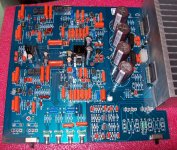
I have find the photos on the internet of the factory psu rated 25,5v*2 and 17,5v*2
However the board has measuring points showing +35, -35, +15, -15 and +5 volts. 25,5 regulated works out for 35, but 17,5 will be lot more than 15.
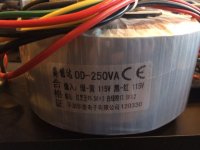
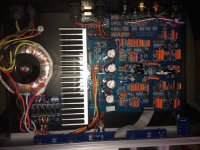
Here is another photo but the transformer here is a center tapped one. The regulator caps look a bit different too, but as far as I know there were no different revisions of the amp.
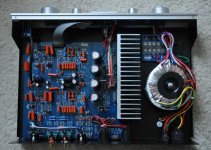
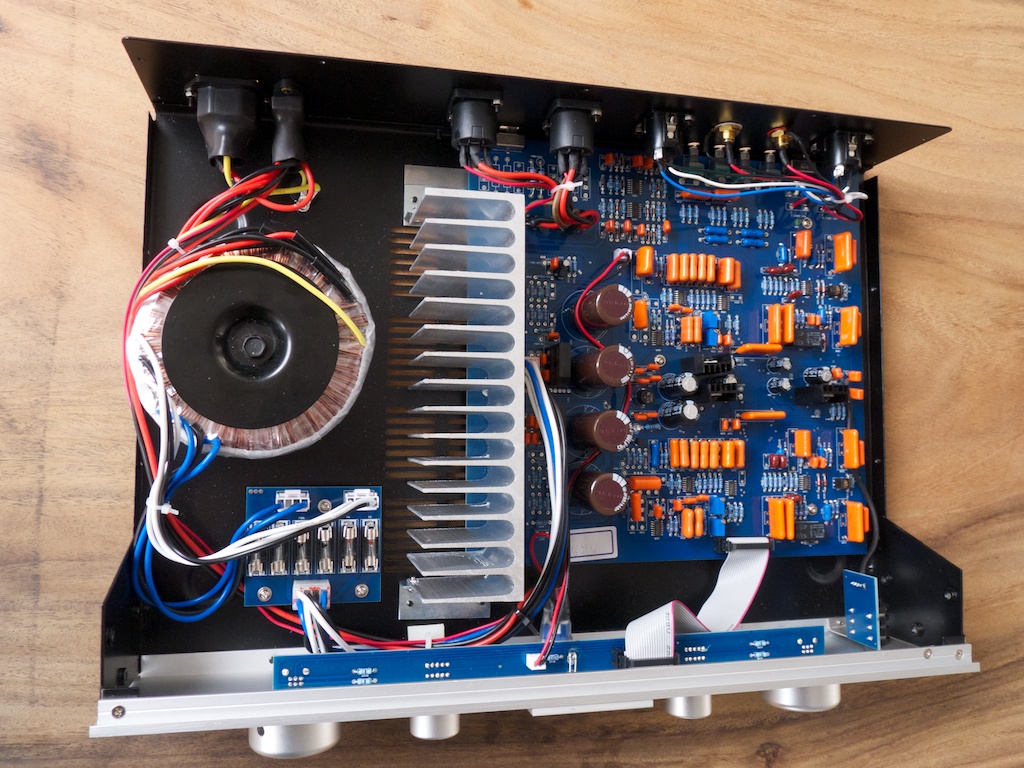
Any ideas? thanks

I have find the photos on the internet of the factory psu rated 25,5v*2 and 17,5v*2
However the board has measuring points showing +35, -35, +15, -15 and +5 volts. 25,5 regulated works out for 35, but 17,5 will be lot more than 15.


Here is another photo but the transformer here is a center tapped one. The regulator caps look a bit different too, but as far as I know there were no different revisions of the amp.


Any ideas? thanks
Last edited:
....factory psu rated 25,5v*2 and 17,5v*2 ... However the board has measuring points showing +35, -35, +15, -15 and +5 volts. 25,5 regulated works out for 35, but 17,5 will be lot more than 15. ...
2*25V AC (or 50VAC CT) will make +/-35V DC, around 60 Watts in 8 Ohms.
2*17VAC (or 34VAC CT) will make +/-24VDC raw which is probably regulated to +/-15V DC clean.
You want a core around that big, 200+VA. The 2*17VAC winding maybe only needs to be 1/4 Amp.
2*25V AC (or 50VAC CT) will make +/-35V DC, around 60 Watts in 8 Ohms.
2*17VAC (or 34VAC CT) will make +/-24VDC raw which is probably regulated to +/-15V DC clean.
You want a core around that big, 200+VA. The 2*17VAC winding maybe only needs to be 1/4 Amp.
Thanks.
Another question. Is there any specific reason for the fuses being on the secondary winding? Shouldn't be a single enough on the primary?
If the low-powered secondary is shorted, it still may not pull enough power to blow the large primary fuses.
This may be especially pointful in DIY, where mistakes happen.
But fusing is often arbitrary designer's preference.
This may be especially pointful in DIY, where mistakes happen.
But fusing is often arbitrary designer's preference.
is there a fuse in the primary circuit?Thanks.
Another question. Is there any specific reason for the fuses being on the secondary winding? Shouldn't be a single enough on the primary?
I would normally not recommend secondary fusing. If the secondary gets abused the close rated mains fuse will blow.
But PRR has hit the nail on the head.
Where a small VA winding is ALSO on the same transformer, then to prevent damage to that small VA winding it would be better to have a secondary fuse on each low VA winding. This could be normal, or F, or T rated depending on the start up surge in the low VA circuits.
The main secondary winding will feed a rectifier and smoothing capacitors before the load.
If any of the rectifier diodes or a smoothing cap goes faulty/shorted then the secondary fuse needs to be located before these components to be of any use.
The current demand at start up is enormous and to survive repeated cold starts the secondary fuse/s needs to be big and probably T rated.
A big fuse like this provides almost no protection to the main secondary winding for a long term overload. A correctly sized close rated mains fuse will blow before a big secondary fuse. This is what saves the transformer.
Last edited:
is there a fuse in the primary circuit?
I would normally not recommend secondary fusing. If the secondary gets abused the close rated mains fuse will blow.
But PRR has hit the nail on the head.
Where a small VA winding is ALSO on the same transformer, then to prevent damage to that small VA winding it would be better to have a secondary fuse on each low VA winding. This could be normal, or F, or T rated depending on the start up surge in the low VA circuits.
The main secondary winding will feed a rectifier and smoothing capacitors before the load.
If any of the rectifier diodes or a smoothing cap goes faulty/shorted then the secondary fuse needs to be located before these components to be of any use.
The current demand at start up is enormous and to survive repeated cold starts the secondary fuse/s needs to be big and probably T rated.
A big fuse like this provides almost no protection to the main secondary winding for a long term overload. A correctly sized close rated mains fuse will blow before a big secondary fuse. This is what saves the transformer.
Since I haven't purchased the transformer yet, shall i go for two trafos instead? One toroid for the big secondary rail and one R core for the small. Like that i would use one fuse each?
Two separate transformers will be much simpler to buy.
Each would have it's own close rated mains/primary fuse.
Then in my blinkered opinion you would not need any secondary fusing.
To get reliable starting on the high VA transformer you will need to use a soft start circuit.
The high resistance of the primary of the low VA transformer acts as it's own current limiter.
You will find that <50VA 230Vac toroid will start reliably on an F500mA mains fuse.
I don't see any need to go to the expense of an Rcore for any of the transformers.
Each would have it's own close rated mains/primary fuse.
Then in my blinkered opinion you would not need any secondary fusing.
To get reliable starting on the high VA transformer you will need to use a soft start circuit.
The high resistance of the primary of the low VA transformer acts as it's own current limiter.
You will find that <50VA 230Vac toroid will start reliably on an F500mA mains fuse.
I don't see any need to go to the expense of an Rcore for any of the transformers.
2*25V AC (or 50VAC CT) will make +/-35V DC, around 60 Watts in 8 Ohms.
2*17VAC (or 34VAC CT) will make +/-24VDC raw which is probably regulated to +/-15V DC clean.
You want a core around that big, 200+VA. The 2*17VAC winding maybe only needs to be 1/4 Amp.
The 35V DC line will feed two stereo chipamps (4 channel total). Will the ~200VA be enough or shall I go for higher rated one?
4 channels each running at 60W full power at the same time will require 4*60W * 1.6 = >384VA
Will the four amplifiers ever run at full power coincidentally?
Domestic duty power amplifiers generally put out average power at around 1% to 10% of maximum power when they are not asked to clip any signals.
A Power Amplifier running at 10%, of full power, i.e. 6W, will probably consume around 15W
4 of these account for ~60W of continuous power demand.
You could run all four amplifiers on domestic duty, provided you don't hold a drunken party where clipping (deliberate or accidental) is almost certain to occur from a 160VA transformer.
I have in the past recommended that a multi-channel domestic duty transformer be rated for two channels at full power and all extra channels at 50% of max.
In your case that would come to 60W+60W+30W+30W = 180W.
The transformer for that could be anywhere in the range 180VA to 360VA.
BTW,
a 25+25Vac transformer running on the UK's 240Vac will give around 50W into 8ohms.
On the continent where mains is likely to be between 220Vac and 230Vac it is more likely the maximum power will be around 45W into 8ohms.
Will the four amplifiers ever run at full power coincidentally?
Domestic duty power amplifiers generally put out average power at around 1% to 10% of maximum power when they are not asked to clip any signals.
A Power Amplifier running at 10%, of full power, i.e. 6W, will probably consume around 15W
4 of these account for ~60W of continuous power demand.
You could run all four amplifiers on domestic duty, provided you don't hold a drunken party where clipping (deliberate or accidental) is almost certain to occur from a 160VA transformer.
I have in the past recommended that a multi-channel domestic duty transformer be rated for two channels at full power and all extra channels at 50% of max.
In your case that would come to 60W+60W+30W+30W = 180W.
The transformer for that could be anywhere in the range 180VA to 360VA.
BTW,
a 25+25Vac transformer running on the UK's 240Vac will give around 50W into 8ohms.
On the continent where mains is likely to be between 220Vac and 230Vac it is more likely the maximum power will be around 45W into 8ohms.
Last edited:
4 channels each running at 60W full power at the same time will require 4*60W * 1.6 = >384VA
Will the four amplifiers ever run at full power coincidentally?
Domestic duty power amplifiers generally put out average power at around 1% to 10% of maximum power when they are not asked to clip any signals.
A Power Amplifier running at 10%, of full power, i.e. 6W, will probably consume around 15W
4 of these account for ~60W of continuous power demand.
You could run all four amplifiers on domestic duty, provided you don't hold a drunken party where clipping (deliberate or accidental) is almost certain to occur from a 160VA transformer.
I have in the past recommended that a multi-channel domestic duty transformer be rated for two channels at full power and all extra channels at 50% of max.
In your case that would come to 60W+60W+30W+30W = 180W.
The transformer for that could be anywhere in the range 180VA to 360VA.
BTW,
a 25+25Vac transformer running on the UK's 240Vac will give around 50W into 8ohms.
On the continent where mains is likely to be between 220Vac and 230Vac it is more likely the maximum power will be around 45W into 8ohms.
Valid point, probably never will go louder than 30%. Even if it's party time, drunk or not 🙂 . Anyhow if I build it I want it to be capable of running full specs so I am not looking to saving on the parts this way.
BTW the amp supposed to deliver 4x50w pc @ 8Ohms, this is the amp chip,but cannot find any info about it.
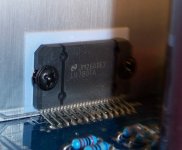
The 4780 is a dual chip 3886 in one package.
It is now obsolete. Maybe Ti took down all references to it.
I have the datasheet in my computer files. Do you want a copy?
I have tested the 3886 chip on a UK power and I find it gives ~50W from a 25Vac transformer.
The EU runs on a slightly lower voltage and that WILL reduce the maximum power available from the amplifier.
if you assume 4 channels all at maximum power of 50W, then a 200VA to 400VA transformer will work for a domestic system.
It is now obsolete. Maybe Ti took down all references to it.
I have the datasheet in my computer files. Do you want a copy?
I have tested the 3886 chip on a UK power and I find it gives ~50W from a 25Vac transformer.
The EU runs on a slightly lower voltage and that WILL reduce the maximum power available from the amplifier.
if you assume 4 channels all at maximum power of 50W, then a 200VA to 400VA transformer will work for a domestic system.
The 4780 is a dual chip 3886 in one package.
It is now obsolete. Maybe Ti took down all references to it.
I have the datasheet in my computer files. Do you want a copy?
I have tested the 3886 chip on a UK power and I find it gives ~50W from a 25Vac transformer.
The EU runs on a slightly lower voltage and that WILL reduce the maximum power available from the amplifier.
if you assume 4 channels all at maximum power of 50W, then a 200VA to 400VA transformer will work for a domestic system.
Yes please for the datasheet.
Well, the amp is going to bi-amp a pair of speakers. I suppose the tweeters will be consuming only half power of the woofer maximum. So probably a 300VA transformer will be adequate.
I had to cheat.
remove the .asc from the file name before you save it.
Cheers
- Status
- Not open for further replies.
- Home
- Amplifiers
- Power Supplies
- Transformer for sE Munro amplifier